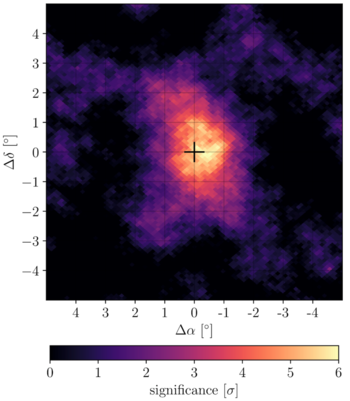TeV Gamma rays from the Quiescent Sun
From RHESSI Wiki
| Nugget | |
|---|---|
| Number: | 454 |
| 1st Author: | Mehr Un NISA |
| 2nd Author: | John BEACOM |
| Published: | August 7, 2023 |
| Next Nugget: | TBD |
| Previous Nugget: | Temporal and Spatial Characteristics of Hard X-Ray Sources in Flare Model with Vertical Current Sheet |
| List all | |
Contents |
Background
The Sun should not be a cosmic gamma-ray source, but it is. This is due both to Galactic cosmic rays producing "albedo" radiation at high energies. The cosmic rays can have extremely high energies, far above the TeV discussed here. Solar flares also accelerate high-energy particles and "solar cosmic rays" SEPs but these are generally at lower energies - "only" a few GeV at most. For reference the solar optical radiation has an effective temperature corresponding to one eV, and even its hot corona to only about 100 eV.
Gamma rays above 1 GeV have been a puzzling feature of the solar disk since they were first measured by Fermi-LAT during solar cycle 24 [1]. Several followup analyses of the data revealed a hard spectrum of gamma rays with the flux exceeding theoretical expectations by up to a factor of 7 [2]. The signal also showed an anticorrelation with solar activity hinting towards a galactic cosmic-ray origin of the gamma-ray excess. Photons with energies up to 200 GeV were detected, motivating a search at even higher energies to understand if the emission continued or cut off.
HAWC Observations
The High Altitude Water Cherenkov (HAWC) Observatory located in Mexico is capable of detecting gamma (and cosmic) rays above a few hundred GeV upto 100s of TeV, and continuously surveys the Northern sky in search of cosmic-ray accelerators in the galaxy and beyond. It has also been taking data from the Sun since beginning operations in 2015. We have analysed six years of archival data between 2015 and 2021, covering both active and quiet periods of the solar cycle. The analysis uses a data-driven approach to separate the very interesting hadronic cosmic-ray shadow of the Sun (see Nugget No. 351) from the disk (Figure 1).
Results
We find a steeply falling excess of gamma rays from the disk with energies between 500 GeV and 2.6 TeV [3]. The image morphology of the signal is best described as a disk of radius 0.24 solar radii. We split the data into two halves: years 2014-2017 corresponding to an active part of the solar cycle, and 2018-2020 which coincided with the last solar minimum. The gamma-ray flux shows a clear time-dependence with most of the signal coming during the solar minimum. The HAWC data combined with previous Fermi-LAT measurements point towards an energy cutoff in the spectrum around 400 GeV (Figure 2), which should be an important clue for theorists trying to model cosmic-ray interactions in the solar atmosphere.
References
[2] "First Observation of Time Variation in the Solar-Disk Gamma-Ray Flux with Fermi"
[3] "Discovery of Gamma rays from the Quiescent Sun with HAWC"
| RHESSI Nugget Date | 7 August 2023 + |
| RHESSI Nugget First Author | Mehr Un NISA + |
| RHESSI Nugget Index | 454 + |
| RHESSI Nugget Second Author | John BEACOM + |

